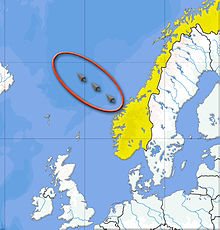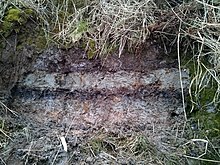
The three Storegga Slides (Norwegian: Storeggaraset) are amongst the largest known submarine landslides. They occurred at the edge of Norway's continental shelf in the Norwegian Sea, approximately 6225–6170 BCE. The collapse involved an estimated 290 km (180 mi) length of coastal shelf, with a total volume of 3,500 km (840 cu mi) of debris, which caused a paleotsunami in the North Atlantic Ocean.
Description

Storegga (Norwegian: Great Edge) is located at the edge of Norway's continental shelf in the Norwegian Sea, 100 km (62 mi) north-west of the Møre coast. In around 6200 BCE, structural failures of the shelf caused three underwater landslides, which triggered very large tsunamis in the North Atlantic Ocean. The collapses involved an estimated 290 km (180 mi) length of coastal shelf, with a total volume of 3,500 km (840 cu mi) of debris.
Based on carbon dating of plant material recovered from sediment deposited by the tsunamis, the latest incident occurred around 6225–6170 BCE. In Scotland, traces of the subsequent tsunami have been recorded, with deposited sediment being discovered in Montrose Basin and the Firth of Forth up to 29 km (18 mi) inland and 4 m (13 ft) above current normal tide levels.
Possible mechanism
The triggering mechanism is thought to have been an earthquake that induced a catastrophic expansion of methane clathrate, a solid compound consisting of large amounts of methane suspended within a crystal water structure that forms in deep oceans under extremely high pressure. If removed from a high-pressure, low-temperature environment, one cubic metre of solid methane clathrate expands to 164 cubic metres of gaseous methane. If such an expansion occurred, it may have weakened the integrity of the surrounding rock sufficiently to trigger the slide.
A second theory states that over time, streams from melting glaciers had carried trillions of tons of sediment to the edge of the continental shelf, where it accumulated in many layers. In this case, a trigger such as an earthquake could have caused a large area of seafloor to collapse into the deep Norwegian sea, thus carrying the enormous volume of accumulated sediment along with it.
Impact on human populations

At, or shortly before, the time of the Second Storegga Slide, a land bridge known to archaeologists and geologists as Doggerland linked Britain, Denmark and the Netherlands across what is now the southern North Sea. This area is believed to have included a coastline of lagoons, marshes, mudflats and beaches, and to have been a rich hunting, fowling and fishing ground populated by Mesolithic human cultures.
Although Doggerland was permanently submerged through a gradual rise in sea level, it has been hypothesized that coastal areas of both Britain and mainland Europe, extending over areas which are now submerged, would have been temporarily inundated by a tsunami triggered by the Storegga Slide. This event would have had a catastrophic impact on the Mesolithic population at the time. It is estimated that up to a quarter of the Mesolithic population of Britain lost their lives.
A 2021 study found that about 600 km (370 miles) of Scotland's northern and eastern coastline were affected, with water encroaching 29 km (18 miles) inland. With present-day populations and sea levels, a similar event today could devastate and destroy seafront and port areas of Arbroath, Stonehaven, Aberdeen, Inverness, Wick, and Montrose.
While the tsunami caused by the Second Storegga Slide would have been devastating for those within the run-in zone, ultimately the tsunami was neither universally catastrophic nor the reason behind the inundation of the last vestiges of Doggerland.
Future slides
Storegga has been thoroughly investigated as part of the preparation activities for the Ormen Lange gas field off the coast of Norway. The prevalent conclusion is that the slide was caused by glacial deposits left behind after the previous glacial period, making any recurrence only possible following a new glaciation. After facts and arguments supporting this conclusion were published in 2004, the development of the Ormen Lange gas field was considered unlikely to increase the risk of triggering a new slide.
See also
References
- P.C. Marrow, "Seismic Monitoring of the North Sea", Global Seismology Research Group, British Geological Society, HSE, 1992
- ^ Bondevik, S.; Mangerud, J.; Dawson, S.; Dawson, A.; Lohne, Ø. (5 August 2003). "Record-breaking Height for 8000-Year-Old Tsunami in the North Atlantic". Eos, Transactions, American Geophysical Union. 84 (31): 289, 293. Bibcode:2003EOSTr..84..289B. doi:10.1029/2003EO310001. hdl:1956/729.
- Bondevik, S; Lovholt, F; Harbitz, C; Stormo, S; Skjerdal, G (2006). "The Storegga Slide Tsunami – Deposits, Run-up Heights and Radiocarbon Dating of the 8000-Year-Old Tsunami in the North Atlantic". American Geophysical Union meeting. Bibcode:2006AGUFMOS34C..01B.
- Bondevik, S; Stormo, SK; Skjerdal, G (2012). "Green mosses date the Storegga tsunami to the chilliest decades of the 8.2 ka cold event". Quaternary Science Reviews. 45: 1–6. Bibcode:2012QSRv...45....1B. doi:10.1016/j.quascirev.2012.04.020.
- ^ Brooks, Libby (4 June 2021). "Ancient tsunami could have wiped out Scottish cities today, study finds". The Guardian.
- Margonellis, Lisa (October 2014). "An Inconvenient Ice". Scientific American. 311 (4). Nature America: 82–89. Bibcode:2014SciAm.311d..82M. doi:10.1038/scientificamerican1014-82. PMID 25314880.
- Skimming the surface of underwater landslides 2016
- "Bryony Coles, "Doggerland Project", University of Exeter Department of Archaeology". Archived from the original on 2015-08-17. Retrieved 2014-05-04.
- Vincent Gaffney, "Global Warming and the Lost European Country"
- Tony Robinson, "Britain's Stone Age Tsunami", Time Team specials, Channel 4 Television, 30 May 2013
- Bernhard Weninger; et al. (Dec 31, 2008). "The catastrophic final flooding of Doggerland by the Storegga Slide tsunami" (PDF). Documenta Praehistorica. 35: 1–24. doi:10.4312/dp.35.1. Archived from the original (PDF) on 2013-03-25.
- Rincon, Paul (May 2014). "Prehistoric North Sea 'Atlantis' ht by 5m tsunami". BBC News. Retrieved 1 May 2014.
- Hill, Jon; Collins, Gareth S.; Avdis, Alexandros; Kramer, Stephan C.; Piggott, Matthew D. (2014). "How does multiscale modelling and inclusion of realistic palaeobathymetry affect numerical simulation of the Storegga Slide tsunami?". Ocean Modelling. 83: 11–25. Bibcode:2014OcMod..83...11H. doi:10.1016/j.ocemod.2014.08.007. hdl:10044/1/18934. ISSN 1463-5003.
- Keys, David (16 July 2020). "How a giant tsunami devastated Britain's Atlantis". The Independent.
- Walker, James; Gaffney, Vincent; Fitch, Simon; Muru, Merle; Fraser, Andrew; Bates, Martin; Bates, Richard (2020). "A great wave: the Storegga tsunami and the end of Doggerland?". Antiquity. 94 (378): 1409–1425. doi:10.15184/aqy.2020.49. hdl:10454/18239. ISSN 0003-598X.
Further reading
- Williams, Sarah C. P. (16 February 2016). "News Feature: Skimming the surface of underwater landslides". Proceedings of the National Academy of Sciences of the United States of America. 113 (7): 1675–78. Bibcode:2016PNAS..113.1675W. doi:10.1073/pnas.1524012113. PMC 4763740. PMID 26884637.
- Walker, James; Gaffney, Vincent; Fitch, Simon; Muru, Merle; Fraser, Andrew; Bates, Martin; Bates, Richard (2020). "A great wave: the Storegga tsunami and the end of Doggerland?". Antiquity. 94 (378): 1409–1425. doi:10.15184/aqy.2020.49. hdl:10454/18239. ISSN 0003-598X.
- Woodroffe, Sarah A.; Hill, Jon; Bustamante-Fernandez, Emmanuel; Lloyd, Jerry M.; Luff, Jake; Richards, Sarah; Shennan, Ian (2023). "On the varied impact of the Storegga tsunami in northwest Scotland". Journal of Quaternary Science. 38 (8): 1219–1232. Bibcode:2023JQS....38.1219W. doi:10.1002/jqs.3539. ISSN 0267-8179.
External links
64°52′N 1°18′E / 64.867°N 1.300°E / 64.867; 1.300
Categories: